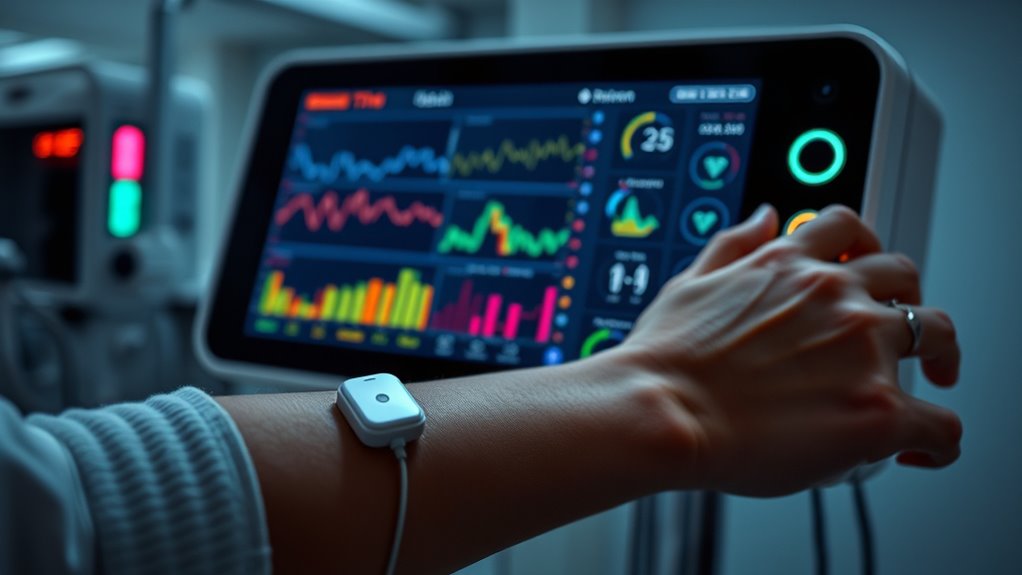AI in real-time diabetes monitoring uses smart algorithms to analyze data from continuous glucose monitors, giving you instant updates on your blood sugar levels. These systems automate testing and insulin adjustments, reducing manual efforts while alerting you to potential highs or lows ahead of time. They personalize insights based on your patterns, helping you manage your condition more effectively. Keep exploring how these innovations can improve your daily glucose control and make managing diabetes more seamless.
Key Takeaways
- AI-powered systems continuously analyze real-time glucose data from CGM devices for immediate insights.
- Automated insulin adjustments use AI algorithms to prevent blood sugar highs and lows proactively.
- Personalized alerts notify users of potential fluctuations before critical episodes occur.
- Ongoing research improves AI prediction accuracy and system responsiveness for better diabetes management.
- Integration with wearable devices and healthcare providers enhances seamless, real-time diabetes monitoring and treatment.

Artificial intelligence is transforming how you monitor and manage diabetes in real time. With AI-powered systems, you get a more precise and automated way to keep your blood sugar levels in check, reducing the stress of manual adjustments. These systems combine continuous glucose monitoring (CGM) devices with smart algorithms that analyze your data instantly. Instead of relying solely on sporadic finger pricks, you receive real-time glucose readings transmitted seamlessly to your smartphone or smartwatch. This constant flow of information allows you to stay aware of your levels and make informed decisions quickly.
AI transforms diabetes management with real-time, automated glucose monitoring and seamless data integration for better control and peace of mind.
One of the key innovations is the closed-loop system, which integrates glucose sensors with AI-driven decision-making. These systems automatically adjust insulin delivery based on your current glucose readings and predicted trends. The AI detection blocks analyze data using advanced algorithms, including machine learning, to determine the precise amount of insulin needed. This automation minimizes manual interventions, making diabetes management less burdensome while maintaining more stable blood sugar levels. The systems can also forecast blood sugar highs and lows up to two hours ahead, giving you vital time to react and prevent dangerous episodes. Additionally, ongoing research into adaptive algorithms promises to further refine prediction capabilities and personalized responses. Incorporating real-time data analysis enhances the system’s ability to adapt swiftly to changing conditions. Furthermore, addressing security vulnerabilities in these systems is essential to ensure your data remains protected from potential breaches.
You benefit from highly personalized insights generated by AI, which adjusts insulin doses according to your individual response patterns. These tailored recommendations improve both hyperglycemia and hypoglycemia management, helping you avoid common fluctuations. Alerts and notifications are a significant feature, warning you about potential highs or lows before they become critical. You can receive these alerts on your phone or smartwatch, allowing you to act promptly and prevent complications. The convenience of having all this information in one place simplifies your routine, making it easier to stay on top of your condition without constant manual calculations. Incorporating advanced flushing mechanisms can further enhance the safety of insulin delivery systems by preventing accidental over-delivery in case of malfunction.
Future developments aim to enhance these systems further. Improved AI algorithms will increase prediction accuracy, and integration with more wearable devices will make management even more seamless. Broader clinical trials are underway to confirm safety and efficacy, paving the way for wider accessibility. As these systems evolve, they may connect more directly with healthcare providers, enabling better coordination and personalized treatment plans. Overall, AI-driven diabetes management offers a safer, more effective, and user-friendly approach, empowering you to take control of your health with less effort and greater confidence.
Frequently Asked Questions
How Does AI Improve Early Detection of Blood Sugar Fluctuations?
You want to know how AI improves early detection of blood sugar fluctuations. AI analyzes data from continuous glucose monitors, medical history, and other sources to spot patterns indicating upcoming highs or lows. Machine learning models predict these changes before they happen, giving you timely alerts. This proactive approach helps you adjust your management plan early, preventing complications and maintaining better blood sugar control over time.
What Are the Privacy Concerns With Real-Time Diabetes Monitoring?
Think of your health data as gold, but it’s often stored without clear rules. You might not know how your information is used or shared, leaving you in the dark. Cybersecurity threats can put your privacy at risk, and policies can change without notice. You have limited control over your data, and many aren’t fully aware of their rights. Protecting your privacy requires transparency, better oversight, and informed consent.
Can AI Predict Long-Term Diabetes Complications Accurately?
You might wonder if AI can predict long-term diabetes complications accurately. While AI models have shown high accuracy in retrospective studies, their real-world effectiveness still needs more validation. You should know that larger, diverse datasets and advanced algorithms like random forests improve predictions. However, prospective clinical validation remains limited. So, while promising, AI’s ability to predict long-term complications reliably isn’t fully established yet, but ongoing research could change that.
How Accessible Is Ai-Powered Monitoring for Underserved Populations?
Think of AI-powered monitoring like a bridge connecting you to better diabetes care, yet for underserved populations, it’s still under construction. Costs, limited internet, and lack of tailored tools act as barriers. While devices are becoming more affordable and telemedicine expands, many still can’t access these innovations. To truly bridge the gap, we need policies and tech that prioritize affordability, connectivity, and cultural relevance for everyone.
What Are the Costs Associated With Implementing AI in Diabetes Care?
You should know that implementing AI in diabetes care involves significant costs. You’ll face upfront expenses for devices like CGMs and insulin pumps, plus infrastructure costs for software and cloud services. Ongoing costs include device replacements, software updates, cybersecurity, and support. Insurance coverage can be a hurdle, making affordability an issue. While market growth promises long-term savings, initial investments and reimbursement challenges can limit widespread access for many patients.
Conclusion
With AI monitoring your diabetes in real time, you stay one step ahead, making smarter decisions for your health. Did you know that AI-powered devices can improve blood sugar control by up to 20%? This technology not only offers precision but also peace of mind, reducing the risk of complications. Embracing AI means taking control now—so you can enjoy a healthier, more confident future.











